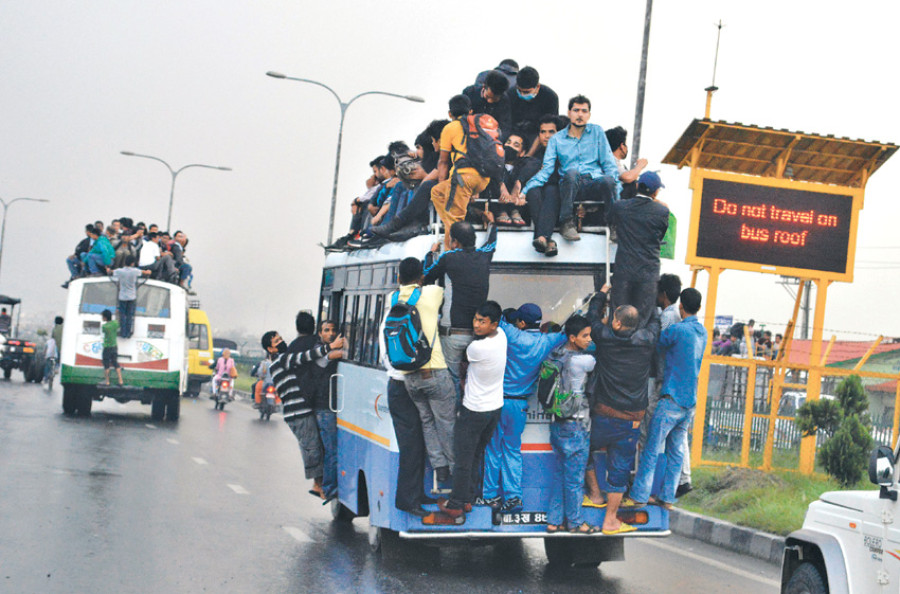Miscellaneous
Reorganising Kathmandu’s public transportation
Kathmandu, as the Capital, should lead the way on reforming the public transport system in the country
Not many people have pleasant memories of commuting via public transportation in Kathmandu. The same can be said for the whole of Nepal, for that matter. The problems are obvious and have their roots in the state abandoning its role as arbiter—a good example of what happens when the market is left unchecked. After 1990s too many private operators were allowed to come in without a basic governing framework in place and as a result, private syndicates were formed to rake in profits with little consideration to the service aspect of operations. Subsequent governments did very little to challenge these syndicates. On the contrary, officials legitimised the role of these syndicates in establishing new routes, determining fares and allowing new operators.
Since the formal start of a public transport system in the Valley in 1959, Nepal’s public transportion has come a long way. The first operator, Nepal Transport Service, operated services between Kathmandu and Patan. Before it closed in 1966, it served more than 10,000 passengers daily. Today more than 3.4 million trips are made in the Valley alone, of which 28 percent is public transport, according to a 2012 JICA study. That roughly amounts to a million passengers travelling on public transportation everyday; And this number could easily double if the system were to become reliable. Even without government subsidy, Nepal’s public transport can be self-sustaining, should the government create a public company to regulate the transport system through a tendering process in order to ensure uniformity of services. As the Post Editorial on Tuesday (Feb 16, 2016) argued, the template for organising public transport should be the focus of any reform. It gave the example of Transport for London (TfL), a local government entity that regulates all public transportation London—through a tendering system that has private operators bid for a set route for a set price. Public transport needs to be based on a public private partnership approach; leaving the task solely to the private operators creates chaos which is a bloat on the image of any great city.
Kathmandu, as the Capital, should lead the way in reforming the public transport system in the country. The first step, of course, is to create a greater Kathmandu public transport authority, along the lines of TfL. This should be followed by the dissolution of the syndicates—a difficult task, but an achievable one if there is political will. The Supreme Court has already issued a verdict ordering dissolution of all syndicates; the government just needs to implement it—using a carrot and stick approach. Old routes need to be revisited for coherence and ease of commuting, while new ones need to opened to ensure maximum connectivity. The Kathmandu Sustainable Urban Transportation Project (KSUTP), funded by ADB and GEF, is already doing some of this work. KSUTP is also working on creating central and peripheral transport hubs around Kathmandu Valley so that transfer of passengers becomes easy and systematised.
KSUTP also plans to have eight primary, 16 secondary and 42 tertiary routes to ensure that all parts of the city are within 600m from the nearest bus stops—bringing down the number of currently operational 200 routes. The project, due to be completed by mid 2017, has understandably done very little on one of its key components—reorganising the operators into one company, if not cooperatives. In order to incentivise the change, Asian Development Bank is willing to provide 80 percent of the cost of buying new buses in soft loans, says KSUTP Director Deepak Shrestha. But the private operators are seeking additional compensation to give up routes and current fleet of small buses and micros.
The project has an ambitious target of revamping the fleet of public vehicles in Kathmandu by mid 2017 by adding about a 1000 new buses to ply on primary and secondary routes, while using micros and tempos in the tertiary routes only. This, if implemented, is likely to decrease traffic congestion and pollution, while cutting down on the travel time for commuters. But much of this reform is contingent upon the private operators cooperating, which by the way things go will be a Herculean task for authorities. Other ambitious big-ticket items like monorails, trams or the bus rapid transit (BRT) can only become a reality if the government succeeds in addressing the bottleneck posed by the private operators.
Yet, if Kathmandu wants to truly become the thriving metropolis that it aspires to be, reorganising its public transportation will be one of the most crucial stepping stones.




 9.12°C Kathmandu
9.12°C Kathmandu







%20(1).jpg&w=300&height=200)

